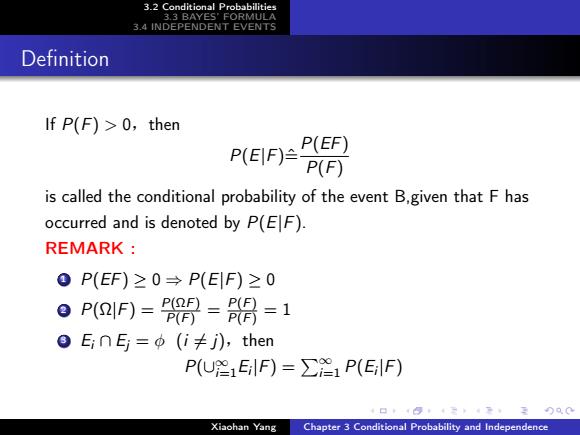
3.2 Conditional Probabilities 3.3 BAYES'FORMULA 3.4 INDEPENDENT EVENTS Definition If P(F)>0,then P1F)=3 P(F) is called the conditional probability of the event B,given that F has occurred and is denoted by P(EF). REMARK: OP(EF)≥0→P(EIF)≥O 。P(F)==9=1 EinE=φ(i≠j),then P(UeEF)=∑1P(EF) Xiaohan Yang Chapter 3 Conditional Probability and Independence
logo 3.2 Conditional Probabilities 3.3 BAYES’ FORMULA 3.4 INDEPENDENT EVENTS Definition If P(F) > 0ßthen P(E|F) ˆ=P(EF) P(F) is called the conditional probability of the event B,given that F has occurred and is denoted by P(E|F). REMARK : 1 P(EF) ≥ 0 ⇒ P(E|F) ≥ 0 2 P(Ω|F) = P(ΩF) P(F) = P(F) P(F) = 1 3 Ei ∩ Ej = φ (i 6= j)ßthen P(∪∞ i=1Ei |F) = P∞ i=1 P(Ei |F) Xiaohan Yang Chapter 3 Conditional Probability and Independence
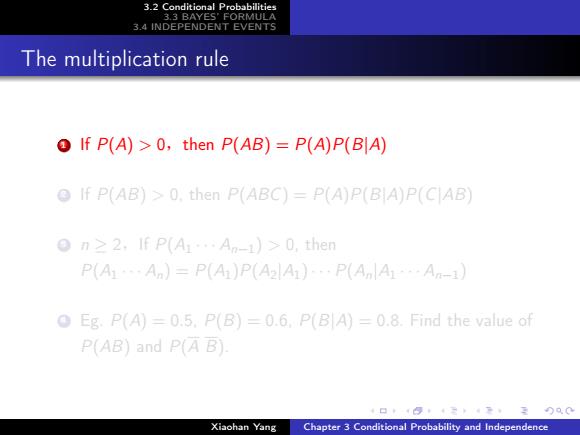
3.2 Conditional Probabilities 3.3 BAYES'FORMULA 3.4 INDEPENDENT EVENTS The multiplication rule If P(A)>0,then P(AB)=P(A)P(BA) If P(AB)>0.then P(ABC)=P(A)P(BA)P(CAB) 0n≥2,lfP(A1-An-)>0,then P(A1An)=P(AP(AA1)…P(AnAA-1 Eg.P(A)-0.5.P(B)=0.6.P(BA)=0.8.Find the value of P(AB)and P(A B) 4口·5,43手。3000 Xiaohan Yang Chapter 3 Conditional Probability and Independence
logo 3.2 Conditional Probabilities 3.3 BAYES’ FORMULA 3.4 INDEPENDENT EVENTS The multiplication rule 1 If P(A) > 0ßthen P(AB) = P(A)P(B|A) 2 If P(AB) > 0, then P(ABC) = P(A)P(B|A)P(C|AB) 3 n ≥ 2ßIf P(A1 · · · An−1) > 0, then P(A1 · · · An) = P(A1)P(A2|A1)· · · P(An|A1 · · · An−1) 4 Eg. P(A) = 0.5, P(B) = 0.6, P(B|A) = 0.8. Find the value of P(AB) and P(A B). Xiaohan Yang Chapter 3 Conditional Probability and Independence
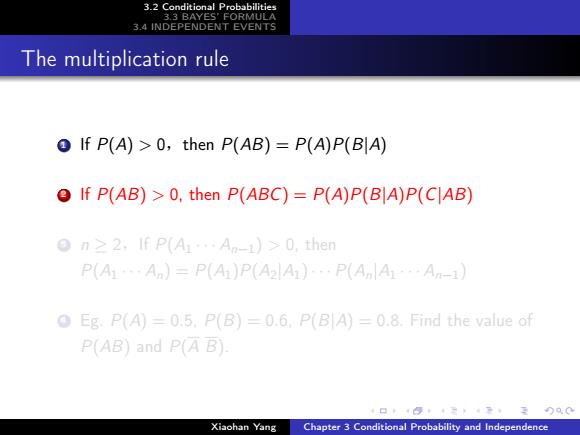
3.2 Conditional Probabilities 3.3 BAYES'FORMULA 3.4 INDEPENDENT EVENTS The multiplication rule If P(A)>0,then P(AB)=P(A)P(BA) If P(AB)>0.then P(ABC)=P(A)P(BA)P(CAB) on>2.If P(A1..An-1)>0,then P(AAn)=P(A)P(A2A)P(AAAn-) Eg.P(A)=0.5.P(B)=0.6.P(BA)=0.8.Find the value of P(AB)and P(A B). 4口t1,13)元,2月00 Xiaohan Yang Chapter 3 Conditional Probability and Independence
logo 3.2 Conditional Probabilities 3.3 BAYES’ FORMULA 3.4 INDEPENDENT EVENTS The multiplication rule 1 If P(A) > 0ßthen P(AB) = P(A)P(B|A) 2 If P(AB) > 0, then P(ABC) = P(A)P(B|A)P(C|AB) 3 n ≥ 2ßIf P(A1 · · · An−1) > 0, then P(A1 · · · An) = P(A1)P(A2|A1)· · · P(An|A1 · · · An−1) 4 Eg. P(A) = 0.5, P(B) = 0.6, P(B|A) = 0.8. Find the value of P(AB) and P(A B). Xiaohan Yang Chapter 3 Conditional Probability and Independence
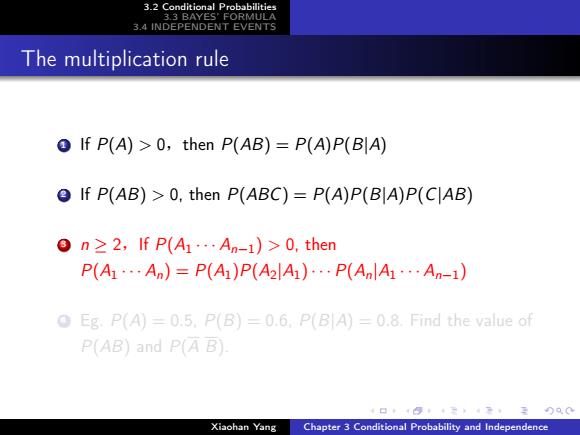
3.2 Conditional Probabilities 3 BAYES'FORMULA 3.4 INDEPENDENT EVENTS The multiplication rule If P(A)>0,then P(AB)=P(A)P(BA) If P(AB)>0,then P(ABC)=P(A)P(BIA)P(CAB) on≥2,fP(A1…An-1)>0.then P(A1…An)=P(A)P(A2A)…P(AnlA…An-1) Eg.P(A)-0.5.P(B)=0.6.P(BA)=0.8.Find the value of P(AB)and P(A B) 4口·5,43手。3000 Xiaohan Yang Chapter 3 Conditional Probability and Independence
logo 3.2 Conditional Probabilities 3.3 BAYES’ FORMULA 3.4 INDEPENDENT EVENTS The multiplication rule 1 If P(A) > 0ßthen P(AB) = P(A)P(B|A) 2 If P(AB) > 0, then P(ABC) = P(A)P(B|A)P(C|AB) 3 n ≥ 2ßIf P(A1 · · · An−1) > 0, then P(A1 · · · An) = P(A1)P(A2|A1)· · · P(An|A1 · · · An−1) 4 Eg. P(A) = 0.5, P(B) = 0.6, P(B|A) = 0.8. Find the value of P(AB) and P(A B). Xiaohan Yang Chapter 3 Conditional Probability and Independence
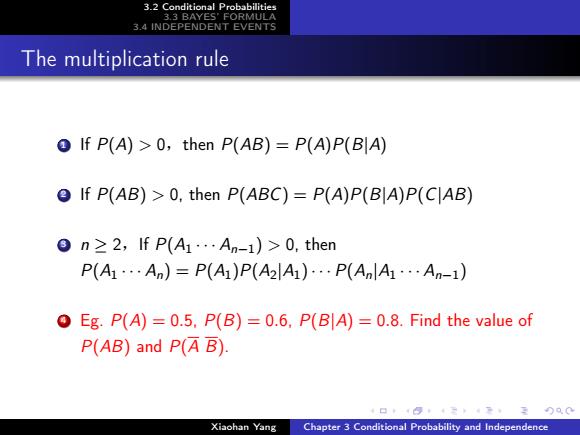
3.2 Conditional Probabilities 3Ay5●有A 3.4 INDEPENDENT EVENTS The multiplication rule If P(A)>0,then P(AB)=P(A)P(BA) If P(AB)>0,then P(ABC)=P(A)P(BIA)P(C|AB) on≥2,fP(A…An-1)>0,then P(A1…An)=P(A)P(A2lA)…P(AnlA…An-1) Eg.P(A)=0.5.P(B)=0.6.P(BA)=0.8.Find the value of P(AB)and P(A B). Xiaohan Yang Chapter 3 Conditional Probability and Independence
logo 3.2 Conditional Probabilities 3.3 BAYES’ FORMULA 3.4 INDEPENDENT EVENTS The multiplication rule 1 If P(A) > 0ßthen P(AB) = P(A)P(B|A) 2 If P(AB) > 0, then P(ABC) = P(A)P(B|A)P(C|AB) 3 n ≥ 2ßIf P(A1 · · · An−1) > 0, then P(A1 · · · An) = P(A1)P(A2|A1)· · · P(An|A1 · · · An−1) 4 Eg. P(A) = 0.5, P(B) = 0.6, P(B|A) = 0.8. Find the value of P(AB) and P(A B). Xiaohan Yang Chapter 3 Conditional Probability and Independence
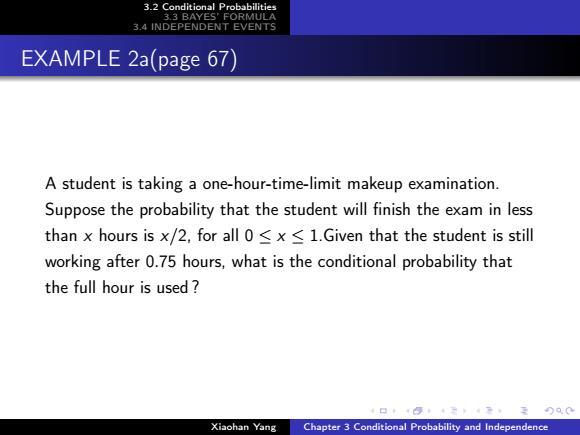
3.2 Conditional Probabilities 83 BAYES'FORMULA 3.4 INDEPENDENT EVENTS EXAMPLE 2a(page 67) A student is taking a one-hour-time-limit makeup examination. Suppose the probability that the student will finish the exam in less than x hours is x/2,for all 0<x 1.Given that the student is still working after 0.75 hours,what is the conditional probability that the full hour is used 口t5:43,手,300 Xiaohan Yang Chapter 3 Conditional Probability and Independence
logo 3.2 Conditional Probabilities 3.3 BAYES’ FORMULA 3.4 INDEPENDENT EVENTS EXAMPLE 2a(page 67) A student is taking a one-hour-time-limit makeup examination. Suppose the probability that the student will finish the exam in less than x hours is x/2, for all 0 ≤ x ≤ 1.Given that the student is still working after 0.75 hours, what is the conditional probability that the full hour is used ? Xiaohan Yang Chapter 3 Conditional Probability and Independence

3.2 Conditional Probabilities 3AY5●有A 3.4 INDEPENDENT EVENTS Example In a 2-children family,Sample space =(b,b),(b.g).(g,b).(g.g). A=one of them is a boy, B=another is a boy. Find the conditional probability of B given A. Xiaohan Yang Chapter 3 Conditional Probability and Independence
logo 3.2 Conditional Probabilities 3.3 BAYES’ FORMULA 3.4 INDEPENDENT EVENTS Example In a 2-children family,Sample space =(b,b),(b,g),(g,b),(g,g), A=one of them is a boy, B=another is a boy. Find the conditional probability of B given A. Xiaohan Yang Chapter 3 Conditional Probability and Independence
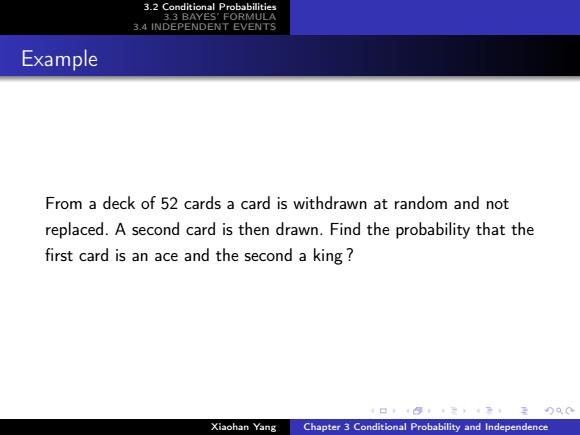
3.2 Conditional Probabilities 3.3 BAYES'FORMULA 3.4 INDEPENDENT EVENTS Example From a deck of 52 cards a card is withdrawn at random and not replaced.A second card is then drawn.Find the probability that the first card is an ace and the second a king? 口t5:43,手,300 Xiaohan Yang Chapter 3 Conditional Probability and Independence
logo 3.2 Conditional Probabilities 3.3 BAYES’ FORMULA 3.4 INDEPENDENT EVENTS Example From a deck of 52 cards a card is withdrawn at random and not replaced. A second card is then drawn. Find the probability that the first card is an ace and the second a king ? Xiaohan Yang Chapter 3 Conditional Probability and Independence
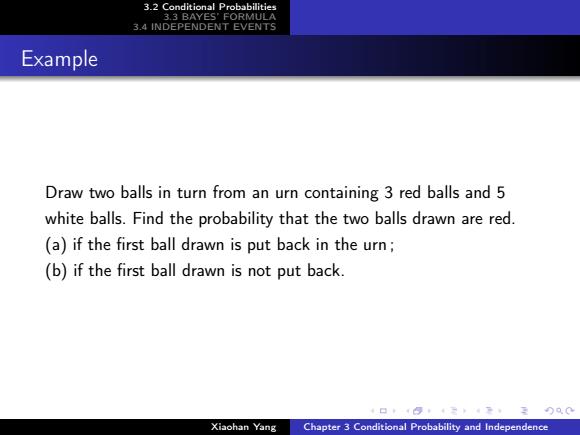
3.2 Conditional Probabilities 3AY5●有A 3.4 INDEPENDENT EVENTS Example Draw two balls in turn from an urn containing 3 red balls and 5 white balls.Find the probability that the two balls drawn are red. (a)if the first ball drawn is put back in the urn; (b)if the first ball drawn is not put back. Xiaohan Yang Chapter 3 Conditional Probability and Independence
logo 3.2 Conditional Probabilities 3.3 BAYES’ FORMULA 3.4 INDEPENDENT EVENTS Example Draw two balls in turn from an urn containing 3 red balls and 5 white balls. Find the probability that the two balls drawn are red. (a) if the first ball drawn is put back in the urn ; (b) if the first ball drawn is not put back. Xiaohan Yang Chapter 3 Conditional Probability and Independence
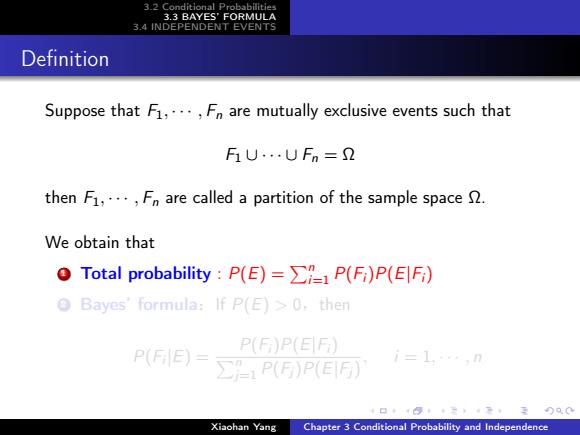
3.2 Conditional Probabilities 3.3 BAYES'FORMULA 3.4 INDEPENDENT EVENTS Definition Suppose that F1,..,Fn are mutually exclusive events such that FU…UFn=2 then F1,...,Fn are called a partition of the sample space We obtain that Total probability P(E)=>P(Fi)P(EF;) Bayes'formula:If P(E)>0.then P(F)P(EF) P(FE)= P(F)P(EIF) 1=1,,n 口t45年42卡手,王00C Xiaohan Yang Chapter 3 Conditional Probability and Independence
logo 3.2 Conditional Probabilities 3.3 BAYES’ FORMULA 3.4 INDEPENDENT EVENTS Definition Suppose that F1, · · · , Fn are mutually exclusive events such that F1 ∪ · · · ∪ Fn = Ω then F1, · · · , Fn are called a partition of the sample space Ω. We obtain that 1 Total probability : P(E) = Pn i=1 P(Fi)P(E|Fi) 2 Bayes’ formulaµIf P(E) > 0ßthen P(Fi |E) = P(Fi)P(E|Fi) Pn j=1 P(Fj)P(E|Fj) , i = 1, · · · , n Xiaohan Yang Chapter 3 Conditional Probability and Independence